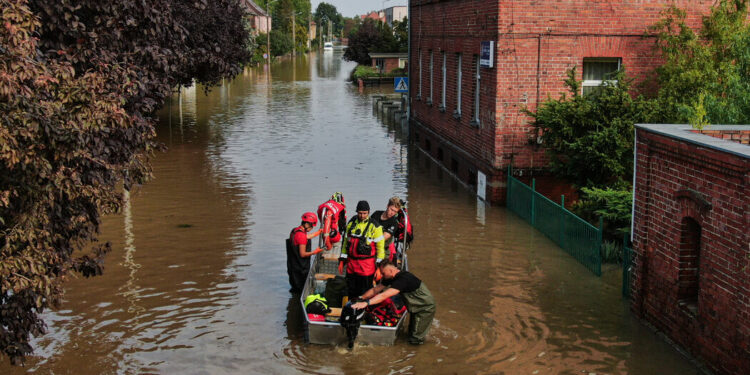Europe faced catastrophic floodwaters that affected two million people earlier this month and transformed neighborhoods and urban centers into muddy rivers. At least 24 people died, and some were reported missing.
That lethal deluge, known as Storm Boris, was made twice as likely by human-induced climate change, according to a new analysis by World Weather Attribution, an international group of scientists and meteorologists who study the role of climate change in extreme weather events.
The storm dropped 7 to 20 percent more rain than a similar one would have in a preindustrial world, before humans started burning fossil fuels and releasing greenhouse gases that have increased global temperatures.
The world is heating up quickly: 2023 was the warmest year on record, and 2024 could still surpass it, according to the National Oceanic and Atmospheric Administration. In the simplest terms, warmer air holds more moisture that contributes to more intense and frequent rainfall.
More than a half-dozen countries in Europe — including Poland, the Czech Republic, Austria, Romania, Hungary, Germany and Slovakia — saw record-breaking amounts of rain between Sept. 12 and Sept 15. The slow-moving, low-pressure system dumped up to five times September’s average rainfall over those four days. The floodwaters led to power cuts and the closure of schools, factories and hospitals.
But it was only one of many flooding events that have wreaked havoc across the world in recent months.
Extreme rainfall that led to flooding and landslides has killed thousands across four continents: a downpour that caused a landslide in India that killed more than 230 people was 10 percent heavier because of climate change; flooding in West and Central Africa caused the deaths of more than 1,000 people and destroyed hundreds of thousands of homes.
Adaptation measures may have helped lower death tolls in Europe, according to World Weather Attribution, especially when compared with intense regional floods in 1997 and 2002 when hundreds died. The continent has invested in forecasting and early warning systems as well as more flood defenses, like levees and bank reinforcements and put in place measures like early water reservoir releases to try to minimize damages.
After pressure from the United Nations, 101 countries now have early-warning protocols, at least on paper, which is double the number that reported having them in 2015.
Those early warnings led to mass evacuations like the one this month in Nysa, Poland, when 44,000 residents fled their town after officials warned an embankment with high water might breach.
But flooding in a warming world will only get worse, according to experts, requiring even more adaptation and mitigation. The mechanisms created so far are not enough, said Maja Vahlberg, a climate risk consultant at the Red Cross Red Crescent Climate Center in the Netherlands.
“We must make flood preparedness and spatial planning a top priority,” Ms. Vahlberg said. “It is critical that we rethink how and where we build to reduce the high exposure to flood risk. Future-proofing our cities demands continuous adaptation.”
The destruction caused by Storm Boris led the European Union to pledge 10 billion euros ($11 billion) in emergency repairs after the extreme rainfall overwhelmed previous efforts to mitigate the worst impacts of climate change.
“As climate change accelerates, we must continue to invest in making our community defense and response systems more resilient,” Ms. Vahlberg said.
Source link : http://www.bing.com/news/apiclick.aspx?ref=FexRss&aid=&tid=66f3a7b4b78745a7aae6375c0d9b7447&url=https%3A%2F%2Fwww.nytimes.com%2F2024%2F09%2F24%2Fclimate%2Fclimate-change-europe-floods-boris.html&c=10939085818989892198&mkt=en-us
Author :
Publish date : 2024-09-24 20:02:00
Copyright for syndicated content belongs to the linked Source.


